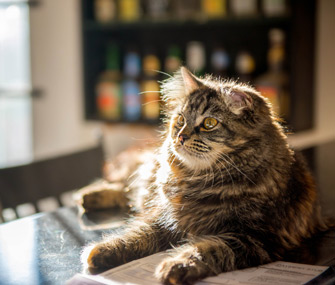Is It Bad to Let My Cat Eat on the Counter?
Published on June 03, 2016
Skip To

But that doesn’t mean that it’s a good idea to let your cat eat on the counter.
Pros and Cons of a Cat on the Counter
Let’s start with the pros of having your cat eat his meals on the kitchen counter: the exercise factor. Assuming you have a young, healthy cat, requiring him to
jump three feet into the air is one way to help ensure that his muscles get a
workout at least twice a day. It also keeps cat food out of reach of
inquisitive dogs or other cats who maybe aren’t capable of jumping that high.But even if Mr. Whiskers thinks you’re the cat’s meow for putting his food in such a cool place, other people — your mother-in-law, for instance, or your finicky next-door neighbor or immunosuppressed friend — may not be quite so comfortable with your cat walking around on the counter. And with good reason: No matter how pristine you keep your cat’s litterbox, it’s still a repository of fecal bacteria and you really don’t want that tracked onto your food preparation area.
That’s not the only reason to make the kitchen counter a no-felines zone. Encouraging your cat to jump on the counter to eat also means he’s more likely to jump up to check out your food as well. That roast chicken you set out to rest before carving? How does your cat know it’s not for him? Well, he doesn’t, and that can be a problem, particularly if he sinks his teeth into something dangerous like garlic or onions.
I’m a fan of feeding cats up high, but the kitchen counter is not the best place to do it. A better choice might be on top of a washer or dryer (but make sure the buzzer will never go off or the fluff cycle start up while your cat is eating). If your cat can access this surface without jumping on the kitchen counter, it can certainly meet his needs for exercise and for privacy when he’s dining.
How to Stop Counter Surfing
If you’d rather not have your cat on the counters but aren’t sure how to discourage the habit, here are some tips to teach him to keep four on the floor — at least in the kitchen.Cats are fussy about what’s beneath their paws. Landing on double-sided tape, a product called Sticky Paws or aluminum foil can have them hopping off the counter faster than they jumped on. To keep the counters useful for yourself, apply the sticky, rough or noisy deterrent to a piece of cardboard or to plastic placemats that you can remove as needed.
I think the best method, though, is to reward your cat for staying off the counter. When you see him up there, pat the counter, say “down” or “off” and pick him up and put him on the floor so he gets the idea. Offer him a treat or toy once he’s on the floor. Repeat consistently, and your cat will soon learn that patting the counter or table signals that you want him on the floor — and that staying down low earns him a reward. Eventually, the verbal command or even a look will be enough to get the message across.
Give your cat an alternative to the counter. He wants to see what you’re doing, so place a stool or cat post at counter height so he can watch from an acceptable spot. Lure him onto it with catnip or a treat and reward him whenever he’s there.
You may still like the idea of feeding your cat on the counter. If that’s so, just be sure to remove your cat and his food and thoroughly clean the counter with hot, soapy water or an antibacterial spray before preparing your own food.
Bon appetit!
More on Vetstreet:

